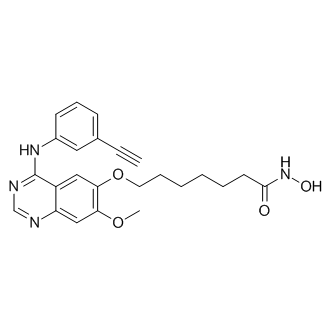| Size | Price | Stock |
|---|---|---|
| 5mg | $55 | In-stock |
| 10mg | $99 | In-stock |
| 25mg | $165 | In-stock |
| 50mg | $275 | In-stock |
| 100mg | $495 | In-stock |
| 200 mg | Get quote | |
| 500 mg | Get quote | |
| We match the lowest price on market. | ||
We offer a substantial discount on larger orders, please inquire via [email protected]
or Fax: (86)21-58955996
Inquiry for price and availability only. Please place your order via our email or fax.
| Cat. No. : | HY-10223 |
| M.Wt: | 434.49 |
| Formula: | C24H26N4O4 |
| Purity: | >98 % |
| Solubility: | DMSO : 25 mg/mL (57.54 mM; Need ultrasonic) |
CUDC-101 is a potent inhibitor of HDAC, EGFR, and HER2 with IC50s of 4.4, 2.4, and 15.7 nM, respectively. CUDC-101 is a click chemistry reagent, itcontains an Alkyne group and can undergo copper-catalyzed azide-alkyne cycloaddition (CuAAc) with molecules containing Azide groups. IC50 & Target: IC50: 4.4 nM (HDAC), 2.4 nM (EGFR), and 15.7 nM (HER2)[1] In Vitro: CUDC-101 inhibits both class I and class II HDACs, but not class III, Sir-type HDACs. CUDC-101 displays broad antiproliferative activity in many human cancer cell types. CUDC-101 is a potent and selective HDAC, EGFR, and HER2 inhibitor with only weak inhibition of the following protein kinases (IC50): KDR (VEGFR2) (849 nM), Src (11000 nM), Lyn (840 nM), Lck (5910 nM), Abl-1 (2890 nM), FGFR-2 (3430 nM), Flt-3 (1500 nM), and Ret (3200 nM)[1]. CUDC-101 (300 nM) inhibits both the full length AR (flAR) and the AR variant AR-V7[2]. CUDC-101 is the most active agent in all three ATC cell lines screened for inhibitors of EGFR and HDACs, with half-maximal inhibitory concentration (IC50) at 0.15 μM for 8505c, and 1.66 μM for both C-643 and SW-1736 cells. CUDC-101 inhibits cancer cell migration and modulates epithelial-mesenchymal transition marker expression in ATC cells. CUDC-101 also inhibits HDAC and MAPK pathway, induces p21, and decreases survivin and XIAP expression in ATC cells[3]. CUDC-101 (1 μM) increases the acetylation of p53 and α-tubulin, nonhistone substrates of HDAC, in treated cancer cells. CUDC-101 modulates RTK activity and expression and exhibits immediate and stable inhibition of RTK and downstream Akt signaling[4]. In Vivo: CUDC-101 (120 mg/kg, iv, daily) induces tumor regression in the Hep-G2 liver cancer model and is more efficacious than erlotinib at its maximum tolerated dose (MTD). In the erlotinib-resistant A549 NSCLC xenograft model, CUDC-101 (120 mg/kg) shows potent inhibition of tumor growth. In the erlotinib-sensitive H358 NSCLC models, CUDC-101 (15, 30, 60 mg/kg, i.v.) inhibits tumor growth in a dose-dependent manner. CUDC-101 (120 mg/kg) causes significant tumor regression in the lapatinib-resistant, HER2-negative, EGFR-overexpressing MDA-MB-468 breast cancer model and the EGFR-overexpressing CAL-27 head and neck squamous cell carcinoma (HNSCC) model. CUDC-101 (120 mg/kg) also inhibits tumor growth in the K-ras mutant HCT116 colorectal and EGFR/HER2 (neu)-expressing HPAC pancreatic cancer models[1]. In an in vivo mouse model of metastatic ATC, CUDC-101 inhibits tumor growth and metastases, and significantly prolongs survival[3]. CUDC-101 (120 mg/kg) is effective against a broad range of tumor types in xenograft models[4].
Lorem ipsum dolor sit amet, consectetur adipisicing elit. Autem earum hic iste maiores, nam neque rem suscipit. Adipisci consequatur error exercitationem fugit ipsam optio qui, quibusdam repellendus sed vero! Debitis.
Inquiry Information- Product Name:
- CUDC-101
- Cat. No.:
- HY-10223
- Quantity:


Your information is safe with us.